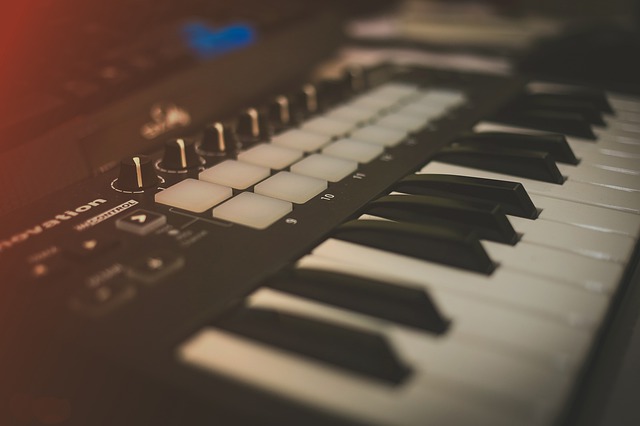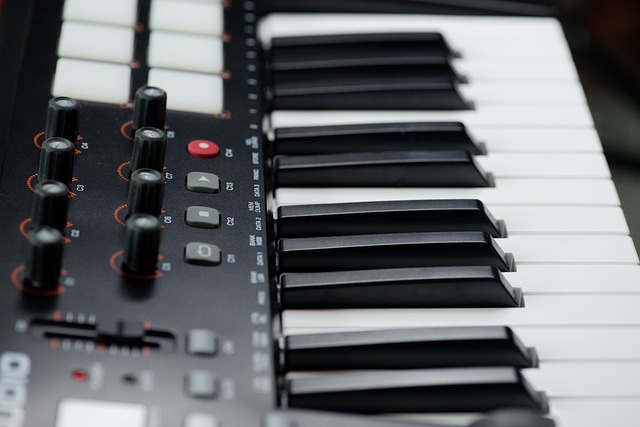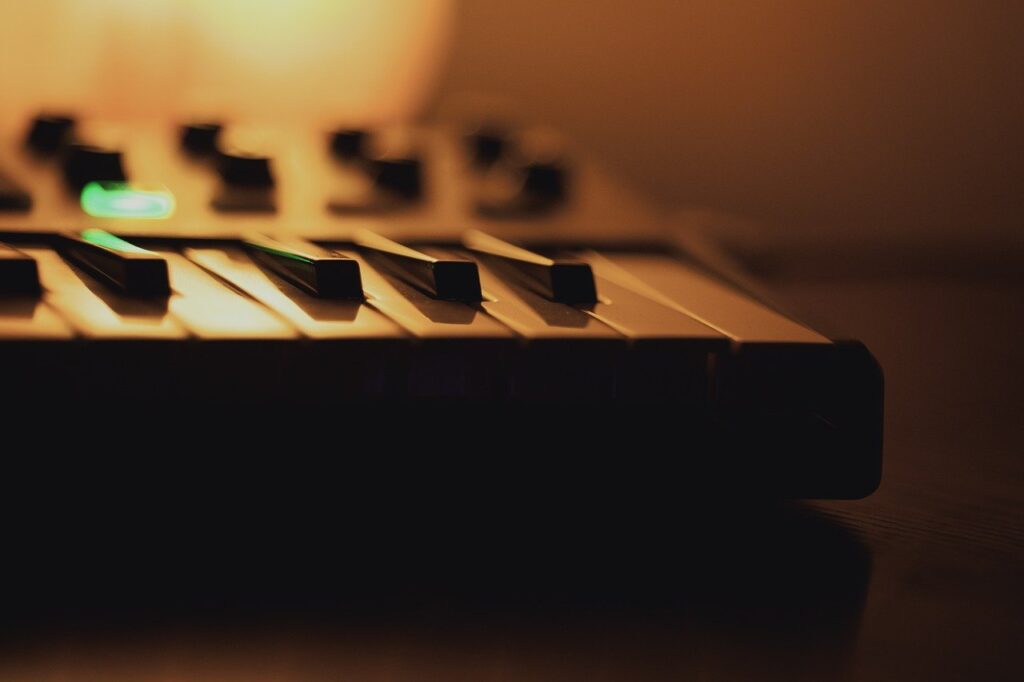Should you get a 25 or 49-key MIDI keyboard?
Is 25 and 49 keys enough?
A MIDI keyboard is a central part of any studio. But with so many variations, deciding which one to buy can be difficult.
Let’s compare them and help you decide which one to buy.
Overview
A 25-key MIDI keyboard is the better option.
25 and 49-key MIDI keyboards serve the same purpose; they give you an easy way to record melodies, basslines, and chord progressions. Except the 25-key option is more compact, portable, and less expensive.
Neither is ideal for simulating the feel of playing a piano keyboard; I recommend at least 61 keys if that’s your goal.
Why are MIDI Keyboards Useful in Music Production?
A MIDI keyboard sends MIDI signals to software instruments, telling them which notes you play – with how much pressure and for how long.
Music producers use them for two main reasons.
Either they want to simulate the feeling of playing a keyboard piano. Or want an efficient way to record note patterns.
Your ideal MIDI keyboard will depend on the function you need it for.
These are the most common MIDI keyboard sizes:
- 25 keys
- 32 keys
- 49 keys
- 61 keys
- 88 keys
25-key and 49-key MIDI keyboards are common in home studios.
But which one is a better option?
Why a 25-key is Better than a 49-key MIDI Keyboard

The answer depends on your situation.
But, we’ll give you some general reasons why a 25-key MIDI keyboard is a better option.
We’ll also explain why you’re better off buying a 61-key MIDI keyboard if you’re considering a 49-key.
To explain why we believe 25 keys is a better than 49 keys, consider your purpose in purchasing a MIDI keyboard; it’s either to:
- Record chord progressions, basslines, and melodies in your DAWs rather than clicking in notes or using your computer keyboard
- Simulate real piano playing- create complex piano pieces
25-Key MIDI Keyboards
A 25-key MIDI controller is the best option for the first goal; it’s all you need for recording basic note patterns.
A 25-key has a two-octave range (the distance between two C notes on a piano is one octave).
While two octaves may not seem like a lot, it’s enough to create complex melodies – if you aren’t a fluent piano player.
With a smaller MIDI keyboard, you can record chord progressions, baseline, and top melodies separately.
Then you can piece them together to create a complex piano piece that sounds like someone played it by hand – producers do this all the time.
Why Not 49-keys?
A 49-key MIDI keyboard accomplishes the same goal as a 25-key- except you’ll pay more for it and use up more space in your studio.
The major difference is a 49 key comes in a four-octave range.
The extra octaves makes the 49-key more suitable for playing keys with two hands and recording complex riffs and progressions.
However, neither option is ideal for imitating the feeling of playing a piano keyboard – the second purpose of buying a MIDI keyboard.
We recommend a 61-key MIDI keyboard over 49-keys if this is your goal.
61-keys give you more flexibility to play keys with two hands and record complex patterns.
It’s also not that much larger than a 49-key MIDI keyboard.
Is a 49-key MIDI Keyboard Enough?
Producers who purchase smaller MIDI keyboards typically record MIDI within one octave at a time.
For this purpose, a 25-key model is ideal; it’s more compact and less expensive than a 49-key.
On the other hand, A 49-key MIDI keyboard has double the octaves of a 25-key.
It’ll give you more flexibility when playing with two hands.
However, we believe the best option for keyboardists is at least 61 keys.
If the size is a concern, a 61-key is only about 7 inches longer than a 49.
If you have 7 inches to spare in your studio, recording melodies on your MIDI keyboard will be more enjoyable.
Differences Between a 25-key and a 49-key MIDI Keyboard

Ultimately, if you’re searching for a smaller MIDI keyboard, you can’t go wrong with either.
The decision comes down to preference and your purpose for using one.
We’ve hinted at a few differences between a 25-key and 49-key MIDI keyboard, but here are some more details to help you make a decision.
Size
- 25-key – Around 13 inches and 2 lbs.
- 49-key – Around 33 inches and 6.5 lbs.
- 61-key – Around 40 inches and 10 lbs
25 key MIDI keyboards are more compact, making them a better option for travel and limited studio space.
Portability is an important factor to consider if you’re using your MIDI keyboard for live shows or traveling to other studios.
Are you okay with your MIDI keyboard taking up a large portion of your desk in your home studio?
A convenient way to store MIDI keyboards is in a keyboard tray. You can fit a 25-key MIDI keyboard in your keyboard tray and keep it out your way – not a 49-key.
You’ll need dedicated space for it for a 49-key MIDI keyboard. The average 49-key is more than double the length of a 25-key.
The size difference is why it’s important to consider your purpose for buying a MIDI keyboard.
Is this space worth sacrificing?
Octaves
One octave is the range between two notes with the same name, where the higher note has a pitch twice as high as the lower note.
For example, one octave is the distance between one C note and the next closest C note on a keyboard.
A 49-key MIDI keyboard has a range of four octaves, while a 25-key has only two.
In comparison, an 88-key piano has 7 octaves.
Neither the 25 nor 49 key MIDI keyboards are ideal for complex piano playing.
However, smaller MIDI keyboards have octave up and down buttons giving you the flexibility to record MIDI within each range of a piano keyboard.
Cost
Generally, the more keys a MIDI keyboard has, the more expensive it’ll be.
However, the cost is also dependent on other factors, such as type of keys, number of knobs, pads, etc.
Other Factors to Consider

Type of Keys
You can purchase a MIDI keyboard with three types of keys: Synth-action, hammer action, and semi-weighted.
Synth-Action Keys
Synth-action keyboards use springs rather than weights to return keys to their original position.
Hammer Action Keys
Hammer action MIDI keyboards have fully weighted keys.
They’re designed to simulate the feeling of playing a real piano.
Semi-Weighted Keys
Semi-weighted is the middle ground between fully-weighted and synth-action.
Knobs and Control
Even small MIDI keyboards come with a combination of knobs and pads.
These features give you more flexibility during production.
Here’s a description of each element of a MIDI keyboard:
Knobs
Knobs let you control levels and parameters without using your mouse.
Drum Pads
A MIDI keyboard with drum pads lets you can manually record percussion sounds and record melodies from one device.
Pitch Wheel
A pitch wheel lets you to add pitch bends to notes as you record MIDI.
Modulation Wheel
You can use a mod wheel to add modulation to notes.
Modulation adds movement to a note – changes its tonal qualities over time.
Takeaway
25-key and 49-key MIDI keyboards are both suitable for music production.
If you have to choose between them, the 25-key is ideal because it’s less expensive, compact, and portable.
Most importantly, it’s all you need to get the job done.
On the other hand, a 49-key MIDI keyboard is fine if you have the space and are willing to pay more.
However, you’re better off buying a 61-key MIDI keyboard at that point. It’s only around 7 inches longer and gives you more flexibility for two-handed piano playing.
In summary, if you don’t intend on using your MIDI keyboard to play keys, 25 keys are all you need to record chord progressions, basslines, and melodies.
Summary
25-key MIDI Keyboard
- Two octave range
- Portable
- Takes up minimal space
- Good for simple chord progressions
- Not ideal for piano playing
49-key MIDI Keyboard
- Four octave range
- Better for complex progressions
- Better for two-handed piano playing but not ideal
- 33-inches long, on average; needs dedicated space








